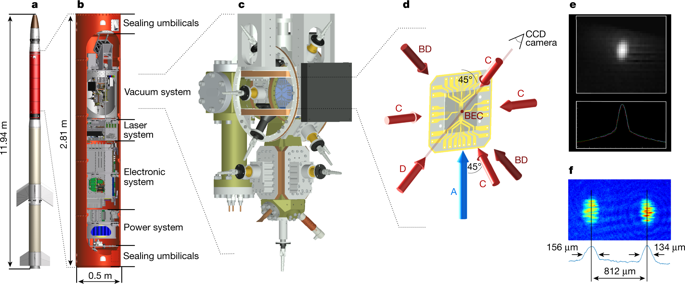Our official English website, www.x-mol.net, welcomes your
feedback! (Note: you will need to create a separate account there.)
Space-borne Bose–Einstein condensation for precision interferometry
Nature ( IF 50.5 ) Pub Date : 2018-10-01 , DOI: 10.1038/s41586-018-0605-1 Dennis Becker , Maike D. Lachmann , Stephan T. Seidel , Holger Ahlers , Aline N. Dinkelaker , Jens Grosse , Ortwin Hellmig , Hauke Müntinga , Vladimir Schkolnik , Thijs Wendrich , André Wenzlawski , Benjamin Weps , Robin Corgier , Tobias Franz , Naceur Gaaloul , Waldemar Herr , Daniel Lüdtke , Manuel Popp , Sirine Amri , Hannes Duncker , Maik Erbe , Anja Kohfeldt , André Kubelka-Lange , Claus Braxmaier , Eric Charron , Wolfgang Ertmer , Markus Krutzik , Claus Lämmerzahl , Achim Peters , Wolfgang P. Schleich , Klaus Sengstock , Reinhold Walser , Andreas Wicht , Patrick Windpassinger , Ernst M. Rasel
Nature ( IF 50.5 ) Pub Date : 2018-10-01 , DOI: 10.1038/s41586-018-0605-1 Dennis Becker , Maike D. Lachmann , Stephan T. Seidel , Holger Ahlers , Aline N. Dinkelaker , Jens Grosse , Ortwin Hellmig , Hauke Müntinga , Vladimir Schkolnik , Thijs Wendrich , André Wenzlawski , Benjamin Weps , Robin Corgier , Tobias Franz , Naceur Gaaloul , Waldemar Herr , Daniel Lüdtke , Manuel Popp , Sirine Amri , Hannes Duncker , Maik Erbe , Anja Kohfeldt , André Kubelka-Lange , Claus Braxmaier , Eric Charron , Wolfgang Ertmer , Markus Krutzik , Claus Lämmerzahl , Achim Peters , Wolfgang P. Schleich , Klaus Sengstock , Reinhold Walser , Andreas Wicht , Patrick Windpassinger , Ernst M. Rasel

|
Owing to the low-gravity conditions in space, space-borne laboratories enable experiments with extended free-fall times. Because Bose–Einstein condensates have an extremely low expansion energy, space-borne atom interferometers based on Bose–Einstein condensation have the potential to have much greater sensitivity to inertial forces than do similar ground-based interferometers. On 23 January 2017, as part of the sounding-rocket mission MAIUS-1, we created Bose–Einstein condensates in space and conducted 110 experiments central to matter-wave interferometry, including laser cooling and trapping of atoms in the presence of the large accelerations experienced during launch. Here we report on experiments conducted during the six minutes of in-space flight in which we studied the phase transition from a thermal ensemble to a Bose–Einstein condensate and the collective dynamics of the resulting condensate. Our results provide insights into conducting cold-atom experiments in space, such as precision interferometry, and pave the way to miniaturizing cold-atom and photon-based quantum information concepts for satellite-based implementation. In addition, space-borne Bose–Einstein condensation opens up the possibility of quantum gas experiments in low-gravity conditions1,2.A Bose–Einstein condensate is created in space that has sufficient stability to enable its characteristic dynamics to be studied.
中文翻译:

用于精密干涉测量的星载玻色-爱因斯坦凝聚
由于太空中的低重力条件,星载实验室能够进行延长自由落体时间的实验。由于玻色-爱因斯坦凝聚具有极低的膨胀能,基于玻色-爱因斯坦凝聚的星载原子干涉仪有可能比类似的地面干涉仪对惯性力具有更高的灵敏度。2017 年 1 月 23 日,作为探空火箭任务 MAIUS-1 的一部分,我们在太空中创造了玻色-爱因斯坦凝聚,并进行了 110 项物质波干涉测量的核心实验,包括激光冷却和在大加速度存在的情况下捕获原子在启动过程中经历。在这里,我们报告了在 6 分钟的太空飞行中进行的实验,其中我们研究了从热系综到玻色-爱因斯坦凝聚体的相变以及由此产生的凝聚体的集体动力学。我们的研究结果为在太空中进行冷原子实验(例如精密干涉测量)提供了见解,并为小型化冷原子和基于光子的量子信息概念以用于基于卫星的实施铺平了道路。此外,星载玻色-爱因斯坦凝聚开辟了在低重力条件下进行量子气体实验的可能性1,2。在空间中产生的玻色-爱因斯坦凝聚具有足够的稳定性,可以研究其特征动力学。我们的研究结果为在太空中进行冷原子实验(例如精密干涉测量)提供了见解,并为小型化冷原子和基于光子的量子信息概念以用于基于卫星的实施铺平了道路。此外,星载玻色-爱因斯坦凝聚开辟了在低重力条件下进行量子气体实验的可能性1,2。在空间中产生的玻色-爱因斯坦凝聚具有足够的稳定性,可以研究其特征动力学。我们的研究结果为在太空中进行冷原子实验(例如精密干涉测量)提供了见解,并为小型化冷原子和基于光子的量子信息概念以用于基于卫星的实施铺平了道路。此外,星载玻色-爱因斯坦凝聚开辟了在低重力条件下进行量子气体实验的可能性1,2。在空间中产生的玻色-爱因斯坦凝聚具有足够的稳定性,可以研究其特征动力学。
更新日期:2018-10-01
中文翻译:

用于精密干涉测量的星载玻色-爱因斯坦凝聚
由于太空中的低重力条件,星载实验室能够进行延长自由落体时间的实验。由于玻色-爱因斯坦凝聚具有极低的膨胀能,基于玻色-爱因斯坦凝聚的星载原子干涉仪有可能比类似的地面干涉仪对惯性力具有更高的灵敏度。2017 年 1 月 23 日,作为探空火箭任务 MAIUS-1 的一部分,我们在太空中创造了玻色-爱因斯坦凝聚,并进行了 110 项物质波干涉测量的核心实验,包括激光冷却和在大加速度存在的情况下捕获原子在启动过程中经历。在这里,我们报告了在 6 分钟的太空飞行中进行的实验,其中我们研究了从热系综到玻色-爱因斯坦凝聚体的相变以及由此产生的凝聚体的集体动力学。我们的研究结果为在太空中进行冷原子实验(例如精密干涉测量)提供了见解,并为小型化冷原子和基于光子的量子信息概念以用于基于卫星的实施铺平了道路。此外,星载玻色-爱因斯坦凝聚开辟了在低重力条件下进行量子气体实验的可能性1,2。在空间中产生的玻色-爱因斯坦凝聚具有足够的稳定性,可以研究其特征动力学。我们的研究结果为在太空中进行冷原子实验(例如精密干涉测量)提供了见解,并为小型化冷原子和基于光子的量子信息概念以用于基于卫星的实施铺平了道路。此外,星载玻色-爱因斯坦凝聚开辟了在低重力条件下进行量子气体实验的可能性1,2。在空间中产生的玻色-爱因斯坦凝聚具有足够的稳定性,可以研究其特征动力学。我们的研究结果为在太空中进行冷原子实验(例如精密干涉测量)提供了见解,并为小型化冷原子和基于光子的量子信息概念以用于基于卫星的实施铺平了道路。此外,星载玻色-爱因斯坦凝聚开辟了在低重力条件下进行量子气体实验的可能性1,2。在空间中产生的玻色-爱因斯坦凝聚具有足够的稳定性,可以研究其特征动力学。











































 京公网安备 11010802027423号
京公网安备 11010802027423号